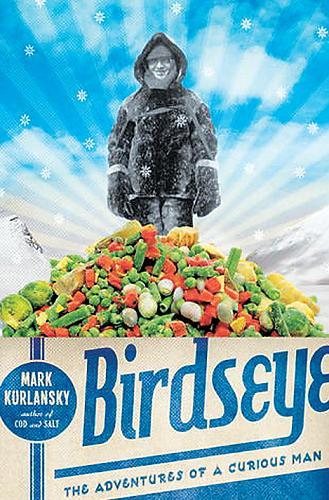
Birdseye: The Adventures of a Curious Man
By Mark Kurlasnky
(Doubleday)
With “Birdseye: The Adventures of a Curious Man,” Mark Kurlansky takes a detour from his food biographies (“Cod,” “Salt,” “The Big Oyster”) to profile Clarence Birdseye, the man credited with launching America’s frozen-food industry. As the subtitle suggests, Birdseye had a wide-ranging curiosity about nature. This led him into many activities, including hunting, taxidermy, research into tick-borne disease, fur farming, whale harpoons, freezing techniques, food packaging, food dehydration, hydroponics and paper-making; he even invented and patented several lightbulb designs. By the time he died in 1956, these activities generated more than 200 patents on more than 50 ideas.
Piecing together the first book-length biography of Birdseye was not easy. It’s not just the episodic quality of Birdseye’s life but the sparse and spotty nature of the surviving information about him. And there are many myths that surround his life, some perpetuated by the man himself.
What we do know is that Birdseye was born in Brooklyn in 1886. Eight years later, his family bought a farm at Orient, on the North Fork of Long Island, where he spent many enjoyable hours trapping small game and preserving the specimens. Eventually, Birdseye found work that suited his love of the outdoors and his peripatetic nature: Employed by the U.S. Biological Survey, he ranged throughout the west, hunting and trapping wild animals for research.
In 1912, Birdseye met a missionary who was heading up an expedition to Labrador, then a part of the Dominion of Newfoundland. Intrigued, Birdseye joined the expedition and spent six weeks there. He was impressed by its icy grandeur and by the abundant seafood and game that filled its forests and waterways. Birdseye returned to Labrador to see if he could make it as a fur trader, trapping and farming silver foxes.
In Labrador, Kurlansky reports, Birdseye observed the Inuit Indians and their methods of freezing foodstuffs. He began developing his own quick-freezing techniques, first learning to freeze food for his foxes and then experimenting with preserving vegetables and then other foods. When the United States entered World War I in 1917, Birdseye returned to America.
In 1926, he launched the General Seafood Company, and soon began marketing a variety of products. His techniques weren’t much different from those employed by others, but, as Kurlansky points out, Birdseye’s U.S. Patent No. 1,773,079 ― describing a method of packaging frozen foods ― “truly began the frozen-food industry.” General Seafood was only modestly successful, but Birdseye was ahead of his time: In the 1920s, there was no infrastructure for shipping frozen food, few freezers in grocery stores and few refrigerators with freezers in American homes.
The Postum Company, manufacturers of breakfast cereals and other food products, was on a buying spree at the time. They gobbled up the General Seafood Company and all of Birdseye’s patents in July 1929. The Postum Company changed its name to General Foods, and in early 1930 launched its frozen food line, called “Birds Eye.” The nation had just entered into the Depression, and the frozen-food industry would not become profitable for almost two decades. The deal, however, made Clarence Birdseye a very rich man.
Kurlansky has pieced together a lively and readable biography about one of America’s most unusual innovators, but the book ends abruptly with Birdseye’s death, leaving the reader wishing for an additional chapter answering a broader question: How did Birdseye’s innovations shape the modern American diet? (MCT)








